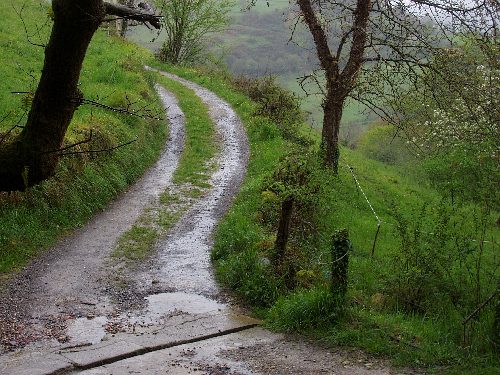13-8-2012
The chestnut forests of the Cévennes are roasting in hot sunlight; the steep valleys and rocky outcrops are glowing green and tawny brown.
 |
| View of Le Castel, looking south-west |
I am staying with my friend Nicolas at Le Castel, a Provençal
mas or farmstead. It lies on the Mediterranean side of the Cévennes, standing on a knoll overlooking the head of the Vallée Française, through which the waters of the youthful Mialet flow on their way to join the River Gard, and ultimately the Rhône.
 |
| Abandoned terraces |
Jean-Baptiste C. has lived here for seven years, but he has just put the place on the market. Originally from Paris, he keeps a handful of sheep in a byre on the ground floor - whence a strong but not unpleasant smell drifts up - otherwise he lives alone with a dog. Le Castel is a dry place on a steep valley side, with a black alkathene pipe from the stream as its sole aqueduct. The soil is very stony; rocks are continually shifting downhill from the granite outcrops above, or breaking out of the scanty soil. The land near the house is arranged in terraces, mostly covered with scrub or trees; elsewhere the slopes are forested. Inside, the house has a dim, lofty feel, with big wooden beams and wicker baskets and sheep bells hanging from them. Pictures with religious associations, ranging through Christianity, Hindiusm and Buddhism, decorate the walls, for Jean-Baptiste is a kind of mystic.
There are other buildings at Le Castel. A ruined farmhouse and barn are situated nearby, with a window lintel engraved
1730. A ruined chapel lies in the valley below, with the remains of an apse and a stone-vaulted ceiling. If you take a goat path slanting up the valley side - through broom, bracken and bramble, along crumbling terraces, past unmanaged chestnut trees and over small ravines - you will come to a roofless stone barn known as a
clède.
.
.
Clèdes are evocative places, like old engine houses in Cornwall. They were once central to rural industry in the Cévennes, being used for smoking, dehusking and drying chestnuts after harvest. In olden days, a fragrant fume would hang over
Cévenol valleys every October, as people processed the
châtaignes which were a staple of their subsistence. Beyond the
clède, the pathway and terraces peter out, and chestnuts give way to rocky moorland with stunted oak trees. Population growth in the 16th century led to a major expansion of chestnut cultivation in the region, we are told: forest clearance accelerated and a major phase of terracing and planting took place; thus the Cévennes became clothed in chestnut forest, within the natural limits dictated by soil and climate
(1). Situated at a valley head, next to the high Atlantic / Mediterranean watershed, Le Castel may lie close to those limits - the high strandline of
châtaigneraie.
 |
| View of Le Castel, sited close to the gorge in the centre |
.
There is a
bronze statue of a naked man in the village of St Germain de Calberte. He is lifting a boulder, and clearly symbolises the monumental effort of people to terrace and transform their mountains into productive land. Le Castel has evidence of much prolonged labour written into its landscape and ruins. I imagine the families that once made their homes here; they created the terraces and buildings over the centuries to make their subsistence. Jean-Baptiste grows a few vegetables and maintains his tiny flock, but he can hardly be described as a
Cévenol farmer. By contrast, the
National Park is trying to maintain historic land-use and culture in the region. For example, it runs workshops on how to look after and revive
la châtaigneraie; it promotes traditional
apiculture; it specifies that roofs are to be made of heavy, overlapping slabs of raw schist known as
lauze. The Park also has a say in who may buy property in its domain: it prefers people with strong local connections. It promotes efforts to record the last scraps of surviving
paysan oral culture
(2). The aim is to conserve local culture and a distinctive sense of place.
Today, we had visitor from Paris, a man interested in buying Le Castel - house, ruins, chapel, terraces, forest and scrub - all 23 hectares. He shares his surname with one of the managers of the National Park. Is he the kind of man to rebuild a productive
Cévenol landscape - can he lift boulders?
Whoever lives at Le Castel, the granite will continue to crumble from the mountain side and wildlife will continue to invest the place with its own anarchic wealth and beauty.
 |
| Episode after rain |
 |
| Jersey Tiger Euplagia quadripunctaria |
(1) 'Votre Chataigneraie' (Parc National des Cévennes, 2008)
(2) Laurence, P,: 'Du Paysage and Des Temps - La memoire orale en Cévennes Vallée Francaise et Pays de Calberte' (Sivom Des Hauts Gardons, 2004)

















